What’s Your Self-Defense IQ?

If you want to see how much evil there is in the world today, just watch or listen to the news outlets. Every day it is filled with reports of rampant crime, much of which is targeted against people. On 4/2/25 in Frisco, Texas Karmelo Anthony, a 17 year old student was charged in the fatal knife stabbing of another 17 year old student, Austin Metcalf, after a verbal confrontation during a high school track meet. Karmelo Anthony is claiming self-defense. He has been charged with murder.

This incident has been highly publicized all over the news and social media outlets the past several weeks. There is a lot of speculation on both sides on what really happened since Austin Metcalf was reportedly himself unarmed at the time of the stabbing. A jury will hear the evidence at a future trial on Karmelo Anthony’s claim of self-defense and then render a verdict based upon the evidence and testimony presented during the trial. The jury will make a determination on whether Karmelo Anthony’s use of force was lawful to support his self-defense claim.
If Karmelo Anthony had a general knowledge of self-defense law and had access to non-lethal resources instead to defend himself, he would have avoided being charged with murder and the life of Austin Metcalf would not have been taken. Karmelo Anthony would have avoided the possibility of life imprisonment for his use of deadly force if convicted. He would have also avoided all the negative media publicity associated with this incident. This case has caused such a media frenzy to the extent that Karmelo Anthony has now been relocated to an undisclosed location over concerns of his personal safety.
Your Right to Protect Yourself

People today are more concerned than ever about their personal safety and self-defense. You could be find yourself facing an imminent physical threat walking to your car in a retail parking lot or leaving your house to drive to work. You don’t get to set the date or time of an attack. Your attacker does. Will you be ready if, and when, that happens?
As a civilian with former law enforcement experience, I am passionate about the study of lawful self-defense and support the Second Amendment as well as your overall right to protect you and your family against criminal predation regardless of whether it’s a deadly or non-deadly force threat. So much so, that I dedicated my Facebook page to lawful self-defense related topics to better educate others.
It is not enough just to own a firearm and think that this will protect you should you face a physical threat or attack. A firearm is NOT a universal weapon for self-defense.
Prepare with Proportional defense
Not all threats or attacks are deadly in nature. In fact, most threats are non-deadly in nature. According to the FBI and Department of Justice, you are five times more likely to be involved in a non-deadly use of force incident than a deadly use of force incident. It is prudent to have both legal and non-lethal/less-lethal tools in your self-defense toolbox.
As someone who lawfully carries a concealed firearm every day in my state of residence (North Carolina) for the last twelve years, I recognize the importance of also having non-lethal and less-lethal resources readily available for self-defense. When I carry my concealed firearm, I also have non-lethal and less-lethal resources with me. By doing so, I am prepared for any threat that I may encounter – whether it is deadly or non-deadly in nature – and I can respond accordingly. The amount of force you are legally allowed to use in self-defense must be proportional. It cannot be greater than the amount of force you are defending against. You can only use deadly force to defend against a threat of death or serious bodily injury. You can use non-deadly force to defend against a threat that will not result in death or serious bodily injury.
Non-Lethal Defense Options

I am also a satisfied customer of HERO Defense Systems. I own both products featured on their website – HERO® 2020 and AIIRO®. I carry them with me whenever I am out in public and find each of them to be a great addition to my self-defense plan. If you don’t currently have a self-defense plan, I encourage you to think about how you can best prepare to protect yourself and your family.. Find what works best for you. HERO® 2020 and AIIRO® products are user friendly and easy to carry and conceal. I can confidently recommend them as a good place to start. As with any self-defense weapon or device, always check your state and local laws in your jurisdiction for any restrictions.
As someone who lawfully carries a concealed firearm every day in my state of residence (North Carolina) for the last twelve years, I recognize the importance of also having non-lethal and less-lethal resources readily available for self-defense. When I carry my concealed firearm, I also have non-lethal and less-lethal resources with me. By doing so, I am prepared for any threat that I may encounter – whether it is deadly or non-deadly in nature – and I can respond accordingly. The amount of force you are legally allowed to use in self-defense must be proportional. It cannot be greater than the amount of force you are defending against. You can only use deadly force to defend against a threat of death or serious bodily injury. You can use non-deadly force to defend against a threat that will not result in death or serious bodily injury.
The Importance of Training

Once you have a plan in place and know what self-defense weapon(s) you will be carrying, you must train in their use. You must learn to be proficient so that you can respond decisively in the moment of crisis. What good is a firearm if you carry it but never go to the firearm range to practice? What good are non-lethal and less-lethal resources such as pepper spray, pepper gel, tasers, etc. if you don’t practice as well on how to effectively use them in neutralizing a threat and immobilizing an attacker. When a threat or attack happens, it is sudden, and you must be prepared to respond immediately in the moment of crisis.
Legal Protection for Self-Defense

Once you prepare yourself for the physical fight you must be prepared for the legal fight as well. Unfortunately, the legal fight is where most people fail to plan. Benjamin Franklin, a Founding Father as well as a signer of the Declaration of Independence and the United States Constitution, summed it up this way: “If you fail to plan, you are planning to fail.” When it comes to self-defense, you want to make sure that you get it right the first time. You want to make sure that you survive the physical fight first and foremost as well as the legal fight that will most certainly follow.
If you are ever compelled to defend yourself from an imminent threat or attack, you will most certainly consider invoking a claim of self-defense as legal justification for your use of defensive force against your assailant(s). Whether your use of non-deadly or deadly force was legally justified will be determined – not by you – but by the results of a police investigation reviewed by a prosecutor, and ultimately by a judge or jury in a criminal trial should you be subsequently charged for unlawful use of force. If you responded with deadly force, for example, you could find yourself being charged with murder, manslaughter, or even aggravated assault depending upon the circumstances of your case. These are serious criminal charges that could result in you spending decades or perhaps life imprisonment if convicted.
The Burden of Production
Regardless of the type of threat (non-deadly or deadly), you do not have an automatic right to argue self-defense in court. You will need to meet what is called the “Burden of Production”. You are not required to produce a lot of evidence; however, you must provide enough evidence to support your self-defense claim. It will be the role of the judge or jury to hear and weigh the evidence during a criminal trial and render a verdict.
You may think you did everything right in defending yourself. After all, you’re the good guy, right? You were the “victim” of an unprovoked attack. How is it possible that you could find yourself being criminally charged for merely defending yourself? You didn’t do anything wrong.
What you “think” you know about self-defense and what the law “actually is” can be two entirely different things.
The 5 Elements of a Legal defense
If only the legal doctrine of self-defense were so simple. The truth is it’s not. For your self-defense claim to be deemed lawful, there are five elements that will be evaluated by a prosecutor. These five elements are cumulative meaning that all five elements must be in your favor to support a lawful self-defense claim. Some elements, such as Avoidance, may be legally waived if you live in a Stand Your Ground state. These 5 elements are the building blocks for your self-defense claim. If a prosecutor can “disprove” any ONE of these elements, then your self-defense claim collapses and you lose your claim for self-defense in its entirety.
What are the five elements of self-defense law?
- Innocence
- Imminence
- Proportionality
- Avoidance
- Reasonableness
The purpose of this article is not intended to conduct a “deep dive” into each of these elements but to provide a general overview of each one.
Let’s look at each of these elements individually:
Innocence

Innocence with respect to self-defense should not be confused with innocent until proven guilty. If you are charged with a criminal offense, the law states that you are presumed innocent until found guilty “beyond a reasonable doubt” by a judge or jury in a criminal trial.
The element of Innocence, as it relates to self-defense, states that you must not be the initial aggressor in a conflict.
Generally speaking, you must not be the first person to use force or threaten to use force. In most states, mere words alone are not enough to make someone the initial aggressor, however, when coupled with an overt act such as a weapon in hand together with threatening language they can make you look like the initial aggressor.
- Mutual combatant: You do not want to be someone who “runs to the fight”. Agreeing to accept an invitation to fight from another person will lose both of you the element of Innocence and neither person will be permitted to claim self-defense.
- Provoker with Intent: Some states distinguish between an initial aggressor and a Provoker with Intent. A Provoker with Intent is someone who “baits” another person into throwing the first punch so they will have an excuse to respond and claim they acted in self-defense (ie: ‘’Throw the first punch, I dare you!”). If you are a Provoker with Intent you own that fight. You lose the element of Innocence and cannot claim lawful self-defense.
Imminence

The element of Imminence refers to an attack that is already in progress or is immediately about to happen.
If you respond with force that is too early (before the threat begins) or too late (after the threat has stopped) this can result in you losing the element of Imminence. Your decision to use force cannot be speculative or futuristic. For example, “For all I know he could have had a gun” or “I thought he was going to go get a gun and come back to shoot me.” You must be able to articulate the threat based upon the evidence in real time.
The AOJ Triad is a great tool to help evaluate Imminence in real time and to help articulate to a judge or jury why you found it necessary to respond with the deemed appropriate level of defensive force. The AOJ Triad consists of three components:
- Ability: Does my attacker have the ability to hurt me? How much harm can they cause me?
- Opportunity: Does my attacker have the opportunity to bring that threat to bear?
- Distance: Someone 25 yards away from you possessing an impact weapon, such as a knife, has the ability to harm you with that knife if they are in close proximity to you and can stab you with the knife. At 25 yards away, however, they are not yet an imminent deadly force threat. On the other hand, someone with a projectile weapon such as a firearm at that same distance, however, would be a deadly force threat.
- Obstacles: If there are no obstacles between you and an attacker, the attacker has the opportunity to bring that threat to bear.
- Jeopardy: Someone who has the ability and opportunity to hurt you and conducts themselves in such a way to suggest they have malicious intent in harming you clearly demonstrates jeopardy. Someone who openly displays a gun on their waist but is not demonstrating any threatening behavior is not placing you in any jeopardy at that moment. On the other hand, an active shooter walking around indiscriminately shooting people would be placing others in jeopardy.
All three components (Ability, Opportunity, and Jeopardy) must be present for a threat to be considered as an imminent threat.
Proportionality

The element of Proportionality means that the amount of defensive force you use against your attacker must not be greater than the amount of force used against you.
- Non-Deadly Force: Often referred to as less-than lethal force, non-deadly force is force that is not expected to cause death or serious bodily injury.
- Deadly Force: Often referred to as lethal force, deadly force is force that is expected to cause death or serious bodily injury. Serious bodily injury can include permanent disfigurement or long-term damage to a part of the body. Examples include (but not limited to) broken bones, loss of a limb, severe burns, spinal cord injuries, traumatic brain injuries, etc.).
Using deadly force in response to a non-deadly force threat will cause you to lose the element of Proportionality in self-defense. If someone punches or slaps you and you respond by stabbing them with a knife or shooting them with a gun, then such force in both situations would be deemed disproportionate and unlawful.
- Duration of Force: You can only use enough force to stop the threat. Once the threat is stopped, you must cease your use of force. For example, if you shoot an attacker and the threat has stopped you cannot continue shooting the attacker as in a “mag dump” of your pistol. Any shots made after the threat has stopped would be considered unnecessary and unlawful.
REMEMBER: You don’t shoot to kill. You shoot to stop the threat
Avoidance
The element of Avoidance relates to whether you are required to retreat before you can use defensive force.
- Duty to Retreat: Some states require that you must retreat first, if safely possible and without increasing your jeopardy, before you are allowed to use defensive force, particularly deadly force. Failure to do so can cost you the element of Avoidance in self-defense. Currently, there are 11 “Duty to Retreat” states:
- Connecticut
- Delaware
- Hawaii
- Maine
- Maryland
- Massachusetts
- Minnesota
- Nebraska
- New Jersey
- New York
- Rhode Island
- Stand Your Ground: The majority of states (39) do not require you to “retreat” but allow you to “stand your ground” and defend yourself if you are in a place you have a right to be. There is no generalized duty to retreat. You can “Stand Your Ground” and defend yourself with proportional force.
- Castle Doctrine: The Castle Doctrine is a legal doctrine that gives people the right to defend themselves with defensive force, including deadly force, when confronted by an intruder in their home. There is no generalized duty to retreat. Some states extend that to common areas outside your actual home dwelling (often referred to as the “curtilage”) such as an attached garage that is part of the everyday use of your property. If an intruder forcibly and unlawfully enters your home, for example, then in many state jurisdictions there is a presumption of death or serious bodily injury under the law, and you may respond with appropriate deadly force. Although there is a legal presumption of death or serious bodily injury, it does not give you absolute license to use deadly force. Presumptions of law are just that – presumptions. Presumptions of law are rebuttable in a court of law. A prosecutor can attempt to attack your self-defense claim under another element of self-defense law, Reasonableness, by attempting to show that it wasn’t necessary to use deadly force. A prosecutor could reasonably attempt to argue before a jury that while you had no generalized duty to retreat in your own home, a reasonable and prudent person could have exercised some other option available to them to avoid having to use deadly force. Your decision to use defensive force will be measured against the “totality of the circumstances” taking into consideration all of the evidence when evaluated by a jury.
Reasonableness
The element of Reasonableness relates to everything you do (actions, perceptions, and decisions) must be reasonable.
Reasonableness has two components as it relates to the use of force:
- Subjective Reasonableness: You had a genuine, good faith fear of imminent injury from your attacker (non-deadly force encounter); death or serious bodily injury from your attacker (deadly force encounter).
- Objective Reasonableness: A hypothetical reasonable and prudent person, given the same circumstances would have a genuine, good faith fear of imminent injury from your attacker (non-deadly force encounter); death or serious bodily injury from their attacker (deadly force encounter).
To satisfy the element of Reasonableness for self-defense, it is required that both components be met. If only one of these components is satisfied, then your claim of self-defense collapses.
Prepare to Protect Yourself legally
There’s a fine line between the legal use of force and a jail cell. Make sure you know the legal boundaries to avoid spending decades of perhaps life imprisonment when acting in self-defense. Self-defense laws vary from state to state. Always check the laws in your state to make sure you know the legal boundaries in your relevant jurisdiction.
Source content for this article is derived largely in part from the following:
Law of Self Defense Principles (Andrew F. Branca). Attorney at Law. Internationally recognized self-defense and use of force expert.


